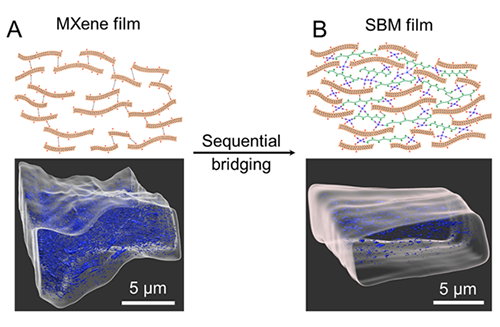Supported by the National Natural Science Fund (grants No.: 52125302, 22075009, 51961130388), a research team led by Prof. Qunfeng Cheng at Beihang University recently made a breakthrough in the field of polymer nanocomposites. This progress entitled “High-strength scalable MXene films through bridging-induced densification” was published in Science on October 1, 2021 (http://www.science.org/doi/10.1126/science.abg2026).
High-strength polymer nanocomposites can potentially solve the bottleneck problems of miniaturization and lightweight in the field of aerospace. Although two-dimensional titanium carbide MXene nanosheets show excellent mechanical and electrical properties, the properties of MXene-based polymer nanocomposites are much lower than expectation. Cheng and his co-workers found that the void is an essential factor to decrease the properties of MXene-based polymer nanocomposites, but usually neglected in the past decades. The true void microstructure of MXene-based polymer nanocomposites was first reconstructed using both focused ion beam and scanning electron microscopy tomography (FIB/SEMT) and nanoscale x-ray computed tomography (nano-CT). These results overturned the conventional densely stacked structure model of polymer nanocomposites. Cheng and his co-workers further developed a simple and effective densification strategy to cure the voids using a sequential bridging process of hydrogen and covalent bonding. The resultant sequentially bridged MXene (SBM) films achieved dramatical improvement in mechanical properties, resistance to cyclic mechanical deformation, oxidation, and stress relaxation etc compared to unbridged MXene films.
In summary, Cheng and his co-workers accomplished a milestone research in the field of polymer nanocomposites, whose key point is detecting and curing the neglected voids in polymer nanocomposites. This pioneer work would overturn the conventional densely stacked structure model of polymer nanocomposites, which would inspire the high-performance assembly of other nanomaterials. This study would also open a new avenue for exploring the relationship between the void microstructure and the performance of polymer nanocomposites.

Figure 1. Structure model and corresponding reconstructed void microstructure for unbridged MXene (A) and SBM (B) films. The blue part represents the voids.

Add: 83 Shuangqing Rd., Haidian District, Beijing, China
Postcode: 100085
Tel: 86-10-62327001
Fax: 86-10-62327004
E-mail: bic@donnasnhdiary.org
京ICP备05002826号 文保网安备1101080035号 Copyright 2017 NSFC, All Right Reserved